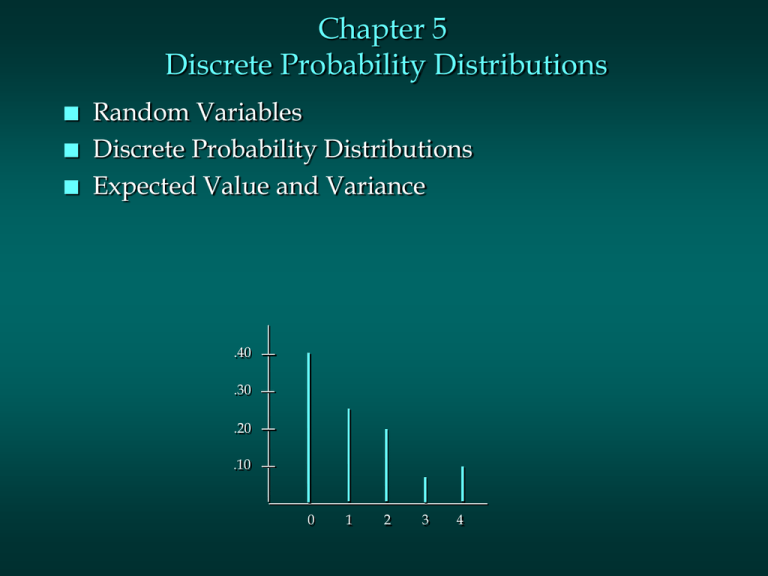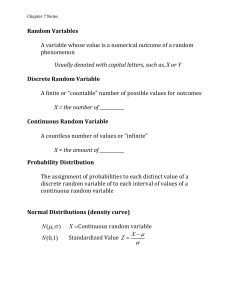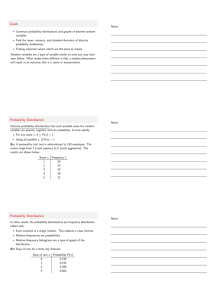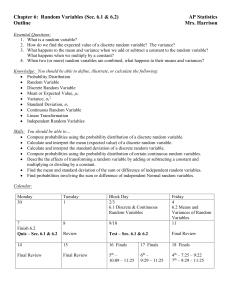Chapter 5 Discrete Probability Distributions Random Variables Expected Value and Variance
advertisement

Chapter 5 Discrete Probability Distributions Random Variables Discrete Probability Distributions Expected Value and Variance .40 .30 .20 .10 0 1 2 3 4 Random Variables A random variable is a numerical description of the outcome of an experiment. A random variable can be classified as being either discrete or continuous depending on the numerical values it assumes. A discrete random variable may assume either a finite number of values or an infinite sequence of values. A continuous random variable may assume any numerical value in an interval or collection of intervals. Example: JSL Appliances Discrete random variable with a finite number of values Let x = number of TV sets sold at the store in one day where x can take on 5 values (0, 1, 2, 3, 4) Discrete random variable with an infinite sequence of values Let x = number of customers arriving in one day where x can take on the values 0, 1, 2, . . . We can count the customers arriving, but there is no finite upper limit on the number that might arrive. Random Variables Question Family size Random Variable x x = Number of dependents in family reported on tax return Type Discrete Distance from x = Distance in miles from home to store home to the store site Continuous Own dog or cat Discrete x = 1 if own no pet; = 2 if own dog(s) only; = 3 if own cat(s) only; = 4 if own dog(s) and cat(s) Discrete Probability Distributions The probability distribution for a random variable describes how probabilities are distributed over the values of the random variable. The probability distribution is defined by a probability function, denoted by f(x), which provides the probability for each value of the random variable. The required conditions for a discrete probability function are: f(x) > 0 f(x) = 1 We can describe a discrete probability distribution with a table, graph, or equation. Example: JSL Appliances Using past data on TV sales (below left), a tabular representation of the probability distribution for TV sales (below right) was developed. Units Sold 0 1 2 3 4 Number of Days 80 50 40 10 20 200 x 0 1 2 3 4 f(x) .40 .25 .20 .05 .10 1.00 Example: JSL Appliances Graphical Representation of the Probability Distribution .50 Probability .40 .30 .20 .10 0 1 2 3 4 Values of Random Variable x (TV sales) Discrete Uniform Probability Distribution The discrete uniform probability distribution is the simplest example of a discrete probability distribution given by a formula. The discrete uniform probability function is f(x) = 1/N where: N = the number of values the random variable may assume Note that the values of the random variable are equally likely. Expected Value and Variance The expected value, or mean, of a random variable is a measure of its central location. E(x) = = xf(x) The variance summarizes the variability in the values of a random variable. Var(x) = 2 = (x - )2f(x) The standard deviation, , is defined as the positive square root of the variance. Example: JSL Appliances Expected Value of a Discrete Random Variable x 0 1 2 3 4 f(x) xf(x) .40 .00 .25 .25 .20 .40 .05 .15 .10 .40 E(x) = 1.20 The expected number of TV sets sold in a day is 1.2 Example: JSL Appliances Variance and Standard Deviation of a Discrete Random Variable x x- (x - )2 f(x) 0 1 2 3 4 -1.2 -0.2 0.8 1.8 2.8 1.44 0.04 0.64 3.24 7.84 .40 .25 .20 .05 .10 (x - )2f(x) .576 .010 .128 .162 .784 1.660 = The variance of daily sales is 1.66 TV sets squared. The standard deviation of sales is 1.2884 TV sets. Example: XYZ Electronics The supervisor of XYZ would like to know what the average number of absentees is daily and also what the standard deviation is of the daily employee absentee rate. Historical data provides the follow probability distribution: Daily Absentees 0 1 2 3 4 5 6 f(x) .50 .23 .12 .10 .02 .02 .01 1.00 Example: XYZ Electronics Expected Value of a Discrete Random Variable x 0 1 2 3 4 5 6 f(x) xf(x) .50 .00 .23 .23 .12 .24 .10 .30 .02 .08 .02 .10 .01 .06 E(x) = 1.01 The expected number of absentees is 1.01 Example: XYZ Electronics Variance and Standard Deviation of a Discrete Random Variable x x- (x - )2 f(x) 0 1 2 3 4 5 6 -1.01 -0.01 0.99 1.99 2.99 3.99 4.99 1.0201 0.0001 0.9801 3.9601 8.9401 15.9201 24.9001 .50 .23 .12 .10 .02 .02 .01 (x - )2f(x) .5101 .0000 .1176 .3960 .1788 .3184 .2490 1.7699 = The variance of absentees is 1.7699 squared. The standard deviation of absentees is 1.3304.





